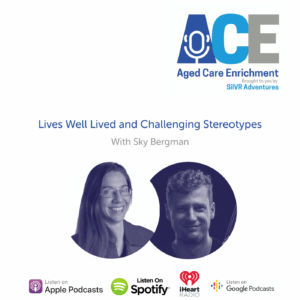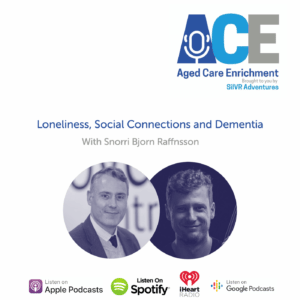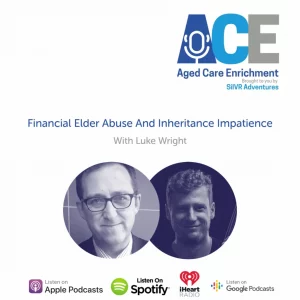Bradley Schurman is an author, consultant and self described “demographic futurist”. His work focuses on how shifting the patterns of shifting age demographics is changing the way we live and work, and how we’re entering unprecedented times.
This conversation takes off straight out of the gate with some really interesting insights from Bradley about birth rate decline in both the USA and China. And how our well meaning plan to have older adults retire from work is actually removing people from our communities.
Throughout the episode, he demonstrates how despite these changes in demographic orientation, we’re entering into one of the most exciting times in the history of the human race. With life expectancy high and new treatments on the horizon, there is much to look forward to.
Transcript
Bradley Schurman: Yeah, I think the big piece that, that we’ll want to mention at some point, or just the demographic numbers that have come out in the past month, that might not be well understood to everybody at this point, because there is such competition for space in the news.
But in the past month, both the United States and China, the two largest economies, have reported, in the United States case birth rates at their lowest point, since we’ve been recording birth rates. Or in China’s case an actual population decline for the first time since 1949, these are really big cases that are happening right now.
And, when you add in the third largest economy Japan, they’re losing about half a million people a year because they don’t have positive birth rates and they don’t have positive immigration. So they’re losing 500 people because of death just because of old age, for the most part. So it’s really kind of wild how we’re seeing this reorienting of the world order.
In fact it’s almost hard to believe, but three quarters of the G 20 economies, three quarters, 75% have birth rates that are below replacement rate.
Ash de Neef: So the G 20 countries are -that’s mainly Western democracies, right?
Bradley Schurman: No, that includes places like Brazil. That includes China. That includes Japan. It’s a large group of countries and they just control the world’s wealth. So imagine 75% of them are having birth rates that don’t meet replacement. That means that their population is getting to a point where it will no longer grow.
And may they actually be in Japan’s case in decline. That’s a significant shift. Where does the wealth go? That’s a big question that no one’s answered yet because this has never happened in the history of the world before where populations decline essentially by attrition. It’s not that people aren’t having sex, it’s the people aren’t having kids.
And there’s a lot of things that you can point to, I believe, in terms of how did this happen? How do we get here? But a lot of it comes down to, industrialization and education at the turn of the last century.
And I think most of your listeners will know these statistics, but at the turn of the last century, you know, our life expectancy was around 40 years old. And in the course of a hundred years we nearly doubled that. And we did that for the most part through solving for infant and youth mortality. The general rule is if you can make it through childhood, you could make it to a relatively old age.
And that’s one of the underpinnings of my research, my book is that, old age isn’t new. Old age is something that’s been around from the beginning of time. Our attitudes towards older people have remained consistently inconsistent throughout history.
On one hand, if you were male if you were part of the elite or the ruling class, you did pretty well late in later life. The roman’s celebrated the 50th birthday for men, not for women.
And men have consistently maintained this position that if you have money, if you have power, you’re allowed to get old. You’re allowed to be sexy, you’re allowed to have license to be cool. But if he didn’t have money, if you didn’t have independence, that’s financial independence you are often seen as the town fool.
Bradley Schurman: For women, their experience with aging is far darker because popular belief for most of history connected childbearing, with a woman’s worth. So when women went through menopause, they lost their inherent value. And, believe it or not, it isn’t even until the middle ages that we see the first utterance of women and the aging process.
And it deals exclusively with menstruation, which is wild, and with menopause. The menstrual blood was considered something that was bad, something that was evil. So when it came out every month, that was a problem. But when it stayed in during menopause, it was even worse.
The texts even say they even go so far as to say women become erratic, they become hard to deal with, they have fevers and chills and they can’t control their emotions. How familiar does that sound to the way some people talk about women and menopause today?
Ash de Neef: Extremely familiar.
Bradley Schurman: Extremely familiar. So I have this belief structure that is, in order for us to see the future. We have to look at the past.
We have to look back it’s where these foundational pieces came from in order for us to address them forthright and in a way that’s actually productive. Because otherwise, we’ll keep spinning the wheels over and over again, and we’ll never see real progress.
Ash de Neef: Wow. So looking back over all these different periods and we started off by talking about how demographics have shifted recently, or this is probably an unprecedented time where populations on a national level are shrinking in some places, Japan, you said…
Bradley Schurman: There are three big factors, three big data points, I think that we can take away from this. The first is last year, due in large part to COVID, populations did experience shifts. Average life expectancies dropped in most countries that had high death rates, obviously the United States is one of those countries.
But last year, and also during periods of economic decline, disease, warfare, you name it, anything that disrupts the normal order, there are also coincides a decrease in birth rates. So last year the United States recorded the lowest birth rates and it’s recorded history of birth rates. So that goes back about a hundred years. That’s significant because the period between let’s say the Spanish flu and the second world war, the great depression was a pretty bad period for this country. And the birth rates are still below that.
So when we take a look at what this means for us, the United States has always had a fairly births we’re well below replacement rates at this point. So in order for the United States to maintain population or to continue to grow, it needs to adopt either a pro birth policy, which rarely works, or it needs to adopt and maintain a pro-immigration policy.
In a place like Japan, Japan’s losing about half a million people a year. Why is that? Well, they’re not having babies, that’s the biggest thing. But the second thing is that they don’t have a pro immigration policy at all. In fact, Japan is the closest thing to a mono-culture that we have perhaps of this entire world.
And their population has been aging. It’s one of the fastest aging countries in the world. But their population decline is essentially people dying from old age.
Bradley Schurman: And then the third is China. You know, China is considered by many to be a very young country, but China had its first population contraction this year since 1949. That means the China is getting very old very quickly. And it’s a country that hasn’t necessarily made the critical investments into its infrastructure, It’s social welfare programs, its financial and healthcare programs to maintain an older population.
And they’re not the only countries three quarters of the G20 are experiencing birth rates that are below replacement rate. And oftentimes you’ll find countries that you’d never even conceive of as being old or having issues with their birth rates falling below that replacement rate.
Both Vietnam and Thailand replacement rate now. Now you’re an Australian you’ve been to those places. Would you think in a million years, they’re below replacement rate? No way, but they are. The data doesn’t lie, population doesn’t lie, demographics don’t lie. Other places like in Eastern Europe, the Balkans, Georgia is a place that’s becoming a super age country by the end of this decade.
Cuba of all places, Cuba is becoming a super aged country by the end of this decade. We define super aged countries as countries that exceed at least 20% of their population over the age of 65. So one out of five people within a country has to be older than 65. That’s how we define it. By the end of this decade, by 2030, we can expect no fewer than 35 countries will have populations that meet this demographic criteria.
Ash de Neef: Wow. It’s huge.
Bradley Schurman: Yeah, it’s a remaking of the social and economic order of the world. And in fact, there’s only really going to be one place where you’re going to find positive birth rates and a relatively young population, and that’s Africa. So if you’re looking to reach youth market, growing youth markets, which is something that we’ve been trained to do essentially for a hundred and some years now, Africa is the place you’re going to have to go.
If you’re more interested in participating in the modern world, it’s a modern world that’s going to look older where people live longer, where we live through multiple stages in life, not just that three stage life that our, grandparents or our great grandparents lived. Where you were a child and adult and then you got old.
Or our parents lived a four-stage life where they were, or maybe five stages where they’re children, teenagers, adults, retirees, and then old. We’re going to be able to actually experience more than that.
And for those that I would say are maybe middle-aged and below, we might actually be at the cusp of catching a wave of innovation that could extend our lives well past anything that we could have possibly imagined just a few decades ago.
Ash de Neef: That’s fantastic. So with these changes do we catch up our attitudes so that it’s not this youth obsessed kind of culture that we’ve had for a long time?
Bradley Schurman: Well money talks, and older populations do tend to hold a higher degree of money. What they spend it on is sometimes different though than younger generations. We are talking about a fundamental reorienting of things and businesses will need to catch up.
In certain categories, automobiles, for example, in the United States two thirds of all new automobiles are purchased by people over the age of 50.
Ash de Neef: Makes sense if that’s where the money is.
Bradley Schurman: It’s where the money is, but also those companies are adjusting to meet those consumers needs.
Many of the innovations that you see in cars today are products of inclusive design. You know, I often say one of the most overlooked features in a car is perhaps one of the most inclusive features of a car. And that’s the push buttons.
Because as we get older, it’s assumed that we will have some challenges with our mobility. So just not having to turn over, a) get that key into the ignition, but then having to turn it over, that liberates people. In a way that, that most average users of an automobile don’t quite understand. They just think of it as isn’t that convenient, I don’t have to take the key out of my pocket.
But when you think about the other parts of the car, they’re also considering safety. They’re also considering challenges to vision, challenges to peripheral vision in particular, challenges to mobility. There are cameras virtually on every corner of a car now, every angle of a car.
There’s drive assist, there’s park assist, there’s all of these things that we think, “aren’t these really cool technological pieces and aren’t they really whizzbang?” And they are, but they’re also designed to help people who would be able to drive otherwise.
Bradley Schurman: My father suffered a stroke a couple of years ago, and the first thing he was concerned about was how do I get around? And the first thing he did was buy a car that could help him get away.
And he traded in one vehicle for another vehicle. And the other vehicle happened to be essentially a sports car. And I said, “what are you thinking dad? This is crazy. Why are you doing this?” And he said, “it’s one of the safest cars I can buy.”And I did my research and lo and behold, it was one of the safest cars he could buy.
People, especially older customers, are so interested in maintaining their independence, their relevancy, their cool factor. They don’t want products and services that look like they’re designed for old people.
And that’s one of the classic mistakes that businesses make is they say, “because you’re old, you no longer have the interest in being relevant, and cool. So we’re just going to design you something ugly, but it works. It’ll work well for you.” Well, people don’t want that.
People want to be able to pick up their iPhone or wear their apple watch or engage in the same ways and in same places as their kids and their grandkids and their great-grandkids.
That’s why certain devices are almost guerilla in their tactics. Apple, I think is one of the best ones. That, that apple watch is essentially a health device at this point. Well, a) younger people don’t have the money to spend on an apple watch necessarily. But b) they’re not as interested in the health metrics as somebody who’s older is. Older people love keeping up on that stuff and they want to make sure that they’re extending their lives, and that’s one way to do it.
Ash de Neef: That’s great. So it’s kind of like, older adults don’t want to be separated out into a distinct category, but by the products and services they’re receiving. Even if the requirements or the features that they value are different.
Bradley Schurman: It’s everything though. It’s not just products and services. Products and services are a big piece, that’s the piece we see every day. But we spent, especially in the west, we spent about a hundred years, let’s trim it back to 75 just for argument’s sake.
We spent about 75 years in the post-war period, systemically removing older people from the workforce and removing older people from our communities.
Bradley Schurman: It was deliberate and it was diligent. And it happened virtually every Western nation. We sold older people on this idea of retirement, we said, “we’ll give you money to get out of the workplace. Once you’re out of the workplace, you can go to Florida, you can go to Arizona.” Where do you go in and Australia for holidays? Where do the retirees go?
Ash de Neef: Probably Queensland is a hot place.
Bradley Schurman: Go to Queensland, yeah, they go to Queensland. And they went there with this promise of living a very comfortable, very active retirement. Well, you know what, for a lot of people that was pretty depressing. It didn’t quite live up to expectations and a growing number of people, a growing cohort of older people are rejecting that notion today.
In 1950 just after the war and when America was really hitting its big economic boom, older people, older men in particular over the age of 65, had a nearly 50% participation rate workforce.
Ash de Neef: Wow.
Bradley Schurman: But because of public policy, because of attitudes towards what older people could do in the workplace, and just an abundance of cheap young labor, the boomers we systematically remove those people from the workforce.
So by 1990 in this country, people over 65 made up 14% of the workforce, that’s nothing. So I wonder, you know, when I graduated, why I saw no older people at work with me, well they weren’t there anymore. They had a generous pension package, they took that up and they moved.
They moved out of their home, into someplace else. They moved out of their communities and to someplace else, and they essentially became erased from the communities that they lived in. It’s pretty depressing. When you think about it.
Ash de Neef: It’s very depressing. What do you suppose that some alternatives to this kind of retirement mentality are?
Bradley Schurman: Don’t stop. Can’t stop. Won’t stop.
For all of human history, really up until the last century, you worked until you couldn’t work anymore.
That was the rule. And then somehow, and I get why we did it. There was a good rationale, there was good underpinning to the idea of creating a universal pension and essentially creating a retirement class of people. It was well intentioned.
But like the best intentions ideas, sometimes they can go awry. I think we’re moving back in many ways to the way the world used to be, where we do continue to work in some way. until we can no longer work. And that’s not a bad thing. For men in particular, we attach a lot of our value to the workplace and the relationships that we’ve developed amongst our peers.
When we’re summarily removed for that position, whether because of forced redundancy or being nudged into retirement, we lose a part of who we are. And we start to die. We get sick, you get physically ill quickly. You can obviously suffer some degrees of mental illness as well. And that’s, to me a problem.
We want to keep people employed, we want to keep people engaged. The more people in the economy, the better for all of us at the end of the day. That’s my mantra. So it doesn’t matter if you’re 18 or 85, if you can work, I’d like to see you work. I think it’s important because there’s a lot that people have to give.
Ash de Neef: Yeah fantastic. And that’s really echoing something that we’re hearing in the podcast about, as populations are aging, and if people are still consistently retiring at the same age, or this huge chunk of people leaving the workforce. It means that there is a greater population that’s going to be needed to be cared for potentially, and a reduced size of the workforce as we age as well.
So that’s removing those boundaries of like, “this is the time that you stop” is going to really smooth out that process and make it a little bit more feasible in the future. I’m guessing.
Bradley Schurman: To me, in many ways, it’s a sustainability issue and our population pyramids are already topsy turvy in many of our countries. Certainly in Australia, certainly in the United States.
Ash de Neef: Can you explain that population pyramid?
Bradley Schurman: So for most of human history, let’s say up until the turn of the last century, we had large numbers of children making up the base of the pyramid and very few older people at the top. So let’s say just for argument’s sake 90% are young and a very small 10 to 5% are old.
Well what’s happened is, over the course of the last century as we’ve extended longevity and decreased birth rates, those population pyramids in some cases have squared off. So we’re seeing a more even distribution of population by age group.
In the most extreme cases in places like Japan, in Italy, the population pyramid, which once stood much like the pyramids of Giza with a large base and a small top is now inverted, and it looks like a top, literally that you can spin upside down.
And that kind of math doesn’t work for society, not when most of the resources for care In particular, need to be delivered to an older population. And most of those care resources need to be delivered by humans hands.
There are obviously attempts in certain economies to automate some of the care giving processes. A couple of years ago, I spent a good bit of time in Japan exploring what these new technologies look like. They’re not going to fulfill the same role as a human being. They don’t have empathy yet.
Ash de Neef: What sort of technologies where you’re looking at?
Bradley Schurman: Well there’s obviously AI technologies, whether they be robots that dance to help keep you physically fit. Or monitoring technologies that exist within nursing homes to alert caregivers of emergencies, rather than being proactive.
It just lacks that human component that I think we want not only for our loved ones, but we also want for ourselves. We want to be cared for, it’s called caring or caregiving, not throw me in front of a robot.
And, you know, there’s something very sci-fi about it and very futuristic about it. But there’s also something that’s very jarring about it as well. Because, and it might just be that the technology’s not there yet. But the bells, the whistles, the beeps, the bops, the boops, that doesn’t equate to a nurse that has empathy, or a PA or a CNA coming into your room and holding your hand, when you’re scared.
Ash de Neef: Yeah.
Bradley Schurman: Or when you’re sick, or when your loved ones can’t come in. Or God forbid in COVID where we had to lock down all these nursing homes for fear of infecting that population that lived there. A robot’s not going to hold your hand. Not yet. Not yet. So I think that there’s quite a bit that, that we still either have to develop or have to think about when it comes to caring for people long-term.
Now I do think there’s some interesting things that are happening on the sidelines, they’re not quite big, bold news yet, they are in some circles. But there is a growing group of longevity, enthusiasts, scientists, doctors, venture capitalists that are starting to put a lot of money into the science of longevity and looking to enhance human life.
Perhaps the name that most people know is Aubrey de Grey. Aubrey is a really interesting Chief Science Officer, I think of the SENS Foundation now. Aubrey has this vision of the future where humans can live for a thousand years.
Now I’m not sure I want to live for a thousand years, let’s be fair. I’m not sure. I know many people that do, but the fundamental premise of what they’re working on is really interesting. Because at the end of the day, what they’re trying to do is compress the amount of time that we’re sick so that when we’re ready to die, we just die. We don’t have this long slow decline.
And to me that offers a lot more promise than worrying about how many nurses I have to get into a hospital. If I only have to worry about taking care of a certain percentage of the population that gets sick for a short period of time, having all that human capital in a nursing center becomes less, less of a priority because there’s not going to be as much demand.
Ash de Neef: Yeah, that’s fantastic. And I saw something, the X prize where there’s a bunch of entrepreneurs are putting money into lots of different projects. There was one I saw about developing avatars that humans can access remotely to then embody a robot of sorts to be with somebody physically.
It’s all science fiction stuff, as you’re saying, but it’s quite exciting to imagine where that can go.
Bradley Schurman: It is exciting, and I think that’s probably the one takeaway that I always want people to hear when I talk. Is I actually think we’re moving into one of the greatest periods of humanity. Imagine not being as afraid of death as we’ve been. Imagine not being as afraid of going into some type of care setting, as we’ve been.
Imagine being able to stay within your community, stay working, stay relevant, stay cool for longer periods of time. That’s wild. Imagine being able to have and live multiple lives, maybe have multiple families. That is interesting to me, and it’s something that we’ve never really experienced as a race of people.
Ash de Neef: Yeah, it is very exciting. And I’m wondering, cause you do some consulting work through your company, The Super Age and if you were advising say an aged care provider, in how they can tailor their services better to an aging demographic, what sort of advice do you think you might be giving? Or what sort of areas would you explore?
Bradley Schurman: Well, I think that big investments in technology are the smartest things that a lot of home care providers in particular, aging care providers, home care providers should be looking at. What happened, you know, the pandemic was terrible, it still is in many places in the world is still, is in many places in the United States.
But that being said, what the pandemic did is it catapulted us forward in ways that we haven’t fully digested yet. And one of the ways that we were catapulted forward was around this area of delivering care at home. Essentially the government got out of the way and let home care agencies in particular play a little bit more; look at different ways that they could deliver care digitally.
And to me, concierge style services that are delivered in home versus residential care setting are the future. So for care providers I think that is probably the first vertical.
Most people don’t want to go into an area. let’s just be clear about that. Nobody is aspirationally saying, “you know what, when I get older, I want to move into a nursing home.” I’ve never heard anyone say that, and I challenge anyone to find me, somebody who has. It’s just not on our list of things to do. It’s not on our bucket list.
Bradley Schurman: So I think with care providers in particular, residential care providers, will they be around? Yes. Are they going to be a bit of a dinosaur? I think so. Home care providers on the other hand, I think it’s the wild west for them right now. They can go as far and as wide as they want, as long as we get some other parts of the physical environments in line.
And that means modifying homes to meet the needs of increasingly older populations that might be challenged by some type of disability. Whether it be hearing or vision or mobility. Having people in the home with that, I think that that helps. But you have to modify the home to meet the person’s daily needs. Can they live alone? But also can they live within their community too?
Most of the built environments in this country, at least on the east coast, started construction in force in the 1800s. Most of our cities were built from the 1900s on. Most of our infrastructure, at least in the center part of DC, was really built in the Victorian period just over a hundred years ago.
But a hundred years ago we built for world that was really young really. Really really young, we didn’t think about old people. Old people became the wards of their family, and the family took care of them in the home, they didn’t have to go out. Well, we don’t have families anymore, not like we did. So the question is how can communities become more responsive?
There are opportunities for technologies that are coming online. One of the first things that people lose is their ability to drive. In a city environment today not only do you have things like Uber and Lyft and Grab and, whatever taxi or ride hailing app you want mention. But we also have scooters and bikes.
I think when we get to that point where we can have automated vehicles, I think we get to that point where we can create more inclusive streetscapes. That’ll make communities not just better for older people who want to live there longer, but better for everyone.
Ash de Neef: Yeah, that’s great. And going back to what you’re saying about the home care, the care of the future is keeping people in their homes as long as possible. We’re seeing in Australia at the moment that there’s…
Bradley Schurman: Let me just be clear about that. It’s not necessarily keeping you in your home, it’s keeping you in your community. So while, people who are younger, we say, “Oh, I want to live in my home for the rest of my life.”
At the time when you’re healthy, yes that is your natural reaction. But when you have your first health event that, that could push you into a residential care setting. Your immediate thought is not, can I stay at my home? It’s can I stay in my community? It changes very quickly.
And yes Is the default, can I stay at hom? 100%. But staying in the community is far more important. People want to be able to get to the grocery store, they want to see their postman, they like their police officer. They enjoy going to church that they’ve been going to for 30, 40 50, 60, 70 years. They like that. They liked their bridge club. They like all of these things. They don’t want that taken away at the core.
So there are some really cool models that are popping up in this country , that are trying to address that. They’re models that are kind of like the Golden Girls model of co-housing for older people. And there’s, one in, based in south Florida right now called Upside Home and they match make people into a existing housing infrastructure.
So they put people into market rate apartments with other people, room mates. And you know, when I spoke to their founder, a couple months ago, I said, “how do you get people to get into the idea of having a roommate? It seems kind of foreign when you’re older to pick up a roommate?” He’s and he said I mean, dead-pan he said, “You spent your life with a room mate. Why would your later life be any different?”
And I said, wait, “I don’t understand what you’re talking about.” He said, “you grew up in a family, you went to college, you had a room mate, you got married, you have a room mate. He said, you only tend to lose a room mate in later life when you lose a spouse.
And it was just like that aha moment of something is just sitting right in front of our faces. But it takes a real innovator to see the opportunity there. Yes, we’ve always been with roommates. Yes we’ve always lived with people. Why should later life be any different? We want to be connected with people, even if it is sharing a home.
Ash de Neef: That’s fantastic. You can see, if people, can get on board with that idea that it’s really going to connect a lot of people and keep them in their community, as you say.
Bradley Schurman: Well, I tell you if, their numbers are any indication, they’re now the largest senior housing provider in Florida without owning a single building.
Ash de Neef: Wow.
Bradley Schurman: That could be the future of residential care. So I think for us to think about the future, we have to really take off a lot of the baggage that we’ve carried from the past, 75 to a hundred years. And say, “the model that we tried, maybe it isn’t the best one.”
Maybe, there is something better that allows people to live more independently, allows people to live the way they choose rather than the way we have to force them into right now.
Ash de Neef: Well, Bradley we’ve, covered heaps today. This has been really great and it’s felt like it’s really flowed between a lot of different conversations. Thank you so much for your time today. Where can people find out more about your work and what we’ve been talking about?
Bradley Schurman: You can always reach us at thesuperage.com. The Super Age: Decoding our Demographic Destiny will be coming out in January of 2022. You can pre-order on Amazon and of course, on other national and international retailers.
Ash de Neef: fantastic. Thanks so much for your time Bradley.
Bradley Schurman: It’s good meeting you.






